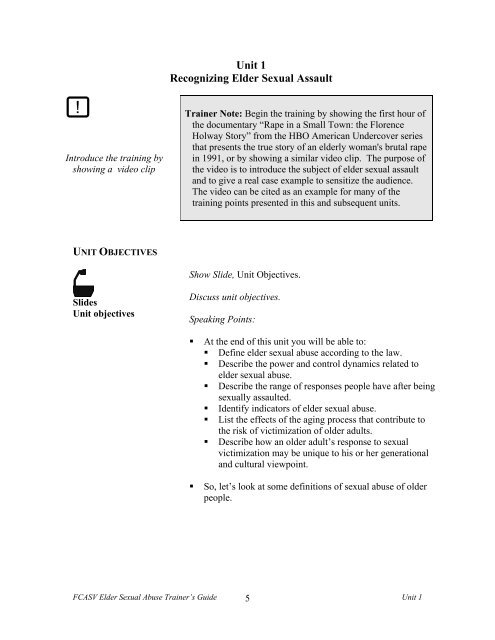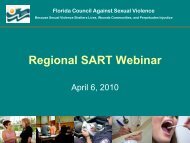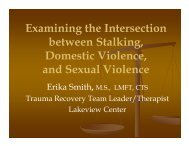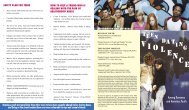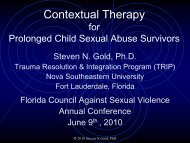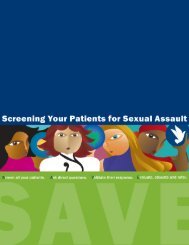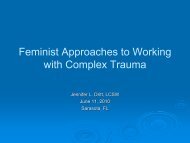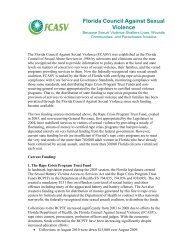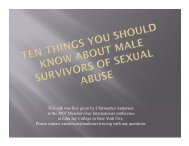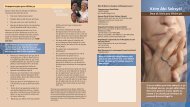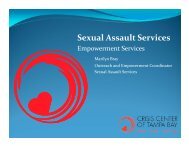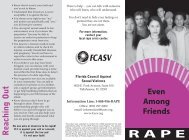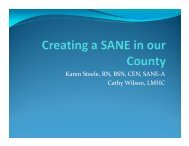Unit 1 - Florida Council Against Sexual Violence
Unit 1 - Florida Council Against Sexual Violence
Unit 1 - Florida Council Against Sexual Violence
You also want an ePaper? Increase the reach of your titles
YUMPU automatically turns print PDFs into web optimized ePapers that Google loves.
<strong>Unit</strong> 1<br />
Recognizing Elder <strong>Sexual</strong> Assault<br />
!<br />
Introduce the training by<br />
showing a video clip<br />
Trainer Note: Begin the training by showing the first hour of<br />
the documentary “Rape in a Small Town: the Florence<br />
Holway Story” from the HBO American Undercover series<br />
that presents the true story of an elderly woman's brutal rape<br />
in 1991, or by showing a similar video clip. The purpose of<br />
the video is to introduce the subject of elder sexual assault<br />
and to give a real case example to sensitize the audience.<br />
The video can be cited as an example for many of the<br />
training points presented in this and subsequent units.<br />
UNIT OBJECTIVES<br />
Show Slide, <strong>Unit</strong> Objectives.<br />
Slides<br />
<strong>Unit</strong> objectives<br />
Discuss unit objectives.<br />
Speaking Points:<br />
• At the end of this unit you will be able to:<br />
• Define elder sexual abuse according to the law.<br />
• Describe the power and control dynamics related to<br />
elder sexual abuse.<br />
• Describe the range of responses people have after being<br />
sexually assaulted.<br />
• Identify indicators of elder sexual abuse.<br />
• List the effects of the aging process that contribute to<br />
the risk of victimization of older adults.<br />
• Describe how an older adult’s response to sexual<br />
victimization may be unique to his or her generational<br />
and cultural viewpoint.<br />
• So, let’s look at some definitions of sexual abuse of older<br />
people.<br />
FCASV Elder <strong>Sexual</strong> Abuse Trainer’s Guide 5<br />
<strong>Unit</strong> 1
ELDER SEXUAL ABUSE<br />
DEFINITIONS<br />
Show Slide, Ramsey/Klawsnik definition<br />
Slide:<br />
Ramsey/Klawsnik<br />
definition.<br />
Speaking Points:<br />
• There are several definitions of elder sexual abuse.<br />
Let’s look at one that was developed by researcher<br />
Ramsey-Klawsnik who studied the prevalence and<br />
patterns of sexual abuse of the elderly.<br />
• According to Ramsey-Klawsnik, sexual abuse of older<br />
adults is: <strong>Sexual</strong> activity that occurs when a person<br />
over age 60 years is forced, tricked, coerced, or<br />
manipulated into unwanted sexual contact.<br />
• This includes situations in which an older adult is<br />
not capable of giving consent because of the<br />
mental/cognitive impairments of aging.<br />
• This isn’t the legal definition, of course, but gives you<br />
a broad idea.<br />
• In <strong>Florida</strong> law, there are a few <strong>Florida</strong> Statutes that<br />
serve as the basis for defining sexual abuse of older<br />
people. The first is Chapter 794, F.S. which defines<br />
sexual battery, and consent. Another is Chapter<br />
825, F.S. which defines lewd and lascivious offenses<br />
against an elderly or disabled person. The last is<br />
Chapter 415, F.S. which defines abuse of certain<br />
elders who are considered vulnerable adults. This<br />
<strong>Florida</strong> statute is the Adult Protective Services Act.<br />
It establishes the authority of the Adult Protective<br />
Services program of the <strong>Florida</strong> Department of<br />
Children and Families and describes your<br />
requirements for collaborating with them on cases<br />
involving abuse of older individuals.<br />
Show Slide, Chapter 794.011, F.S. – definition of sexual<br />
battery.<br />
Slide:<br />
<strong>Sexual</strong> battery<br />
definition<br />
Speaking Points:<br />
• In <strong>Florida</strong> law, sexual battery is defined as "oral, anal,<br />
or vaginal penetration by, or union with, the sexual<br />
organ of another or the anal or vaginal penetration<br />
FCASV Elder <strong>Sexual</strong> Abuse Trainer’s Guide 6<br />
<strong>Unit</strong> 1
of another by any other object; however, sexual<br />
battery does not include an act done for a bona fide<br />
medical purpose.”<br />
• This definition pertains to any victim regardless of age<br />
or functioning ability.<br />
Show Slide, Chapter 794.011, F.S. – definition of consent.<br />
Slide:<br />
Consent definition.<br />
Speaking Points:<br />
• The other legal definition pertaining to sexual battery is<br />
that of “consent.” Consent is defined as “intelligent,<br />
knowing, and voluntary consent and does not<br />
include coerced submission. Consent shall not be<br />
deemed or construed to mean the failure by the<br />
alleged victim to offer physical resistance to the<br />
offender.”<br />
• Determining capacity to consent is tricky with some<br />
older individuals and is best done with the help of<br />
professionals who work with older individuals, such<br />
as Adult Protective Service workers.<br />
Slide:<br />
Lewd and lascivious<br />
offense definitions<br />
Show Slide, Chapter 825.1025 - Lewd or lascivious offenses<br />
committed upon or in the presence of an elderly person or<br />
disabled person.<br />
Speaking Points:<br />
• Another definition pertaining to sexual violence against<br />
the elderly is found in Chapter 825.<br />
• Lewd or lascivious battery upon an elderly person or<br />
disabled person" occurs when a person encourages,<br />
forces, or entices an elderly person or disabled<br />
person to engage in sadomasochistic abuse, sexual<br />
bestiality, prostitution, or any other act involving<br />
sexual activity, when the person knows or<br />
reasonably should know that the elderly person or<br />
disabled person either lacks the capacity to consent<br />
or fails to give consent.<br />
• "Lewd or lascivious molestation of an elderly person or<br />
disabled person" occurs when a person intentionally<br />
touches in a lewd or lascivious manner the breasts,<br />
FCASV Elder <strong>Sexual</strong> Abuse Trainer’s Guide 7<br />
<strong>Unit</strong> 1
genitals, genital area, or buttocks, or the clothing<br />
covering them, of an elderly person or disabled<br />
person when the person knows or reasonably should<br />
know that the elderly person or disabled person<br />
either lacks the capacity to consent or fails to give<br />
consent.<br />
Ask for examples of lewd and lascivious battery and<br />
molestation.<br />
Show Slide, Chapter 825.101--definitions<br />
Slide:<br />
Elderly person<br />
definition<br />
Speaking Points:<br />
• Another definition found in Chapter 825 is one<br />
defining “elderly person”<br />
• Elderly person" means a person 60 years of age or<br />
older who is suffering from the infirmities of aging<br />
as manifested by advanced age or organic brain<br />
damage, or other physical, mental, or emotional<br />
dysfunctioning, to the extent that the ability of the<br />
person to provide adequately for the person's own<br />
care or protection is impaired.”<br />
REFER TO PARTICIPANT<br />
GUIDE, PAGE 4:<br />
FLORIDA STATUTES,<br />
CHAPTER 415<br />
Refer participants to Participant Guide, page 4, <strong>Florida</strong><br />
Statutes, Chapter 415.<br />
Speaking Points:<br />
• Chapter 415 also specifically addresses sexual abuse<br />
of the elderly, along with other types of abuse,<br />
neglect, and exploitation.<br />
• The statute is the Adult Protective Services Act and<br />
refers to disabled and certain elderly adults as<br />
“vulnerable” adults.<br />
• This is similar to the definition of an elderly person in<br />
Chapter 825, defined as being 60 years of age or older<br />
and experiencing the infirmities of aging.<br />
• Adult Protective Service workers are given the<br />
authority and training to determine whether an<br />
older person is experiencing the “infirmities of<br />
FCASV Elder <strong>Sexual</strong> Abuse Trainer’s Guide 8<br />
<strong>Unit</strong> 1
aging, according to statute.<br />
• We will talk more about exactly what are the<br />
infirmities of aging later in this unit.<br />
Show Slide, Chapter 415, F.S. – definition of sexual abuse.<br />
Slide:<br />
<strong>Sexual</strong> abuse definition<br />
Speaking Points:<br />
• “<strong>Sexual</strong> Abuse” is further defined in Chapter 415 as<br />
“acts of a sexual nature committed in the presence<br />
of a vulnerable adult without that person’s<br />
informed consent.”<br />
• This includes, but isn’t limited to “fondling, exposure<br />
of a vulnerable adult’s sexual organs, or the use of a<br />
vulnerable adult to solicit for or engage in<br />
prostitution or sexual performance.” Notice the<br />
similarity between this definition and the lewd and<br />
lascivious offenses listed in Chapter 825.<br />
• <strong>Sexual</strong> abuse does not include any act intended for a<br />
valid medical purpose or any act that may<br />
reasonably be construed to be normal care-giving<br />
action or appropriate display of affection.<br />
• Example: Bathing a person is normal care-giving.<br />
However, inserting objects or fingers rectally or<br />
vaginally is not a normal care-giving activity while<br />
bathing.<br />
Show Slide, Chapter 415, F.S. – definition of informed<br />
consent, capacity to consent.<br />
Slide:<br />
Capacity to consent<br />
Speaking Points:<br />
• With vulnerable adults, a person’s capacity to<br />
consent must be considered.<br />
• Chapter 415 defines Capacity to Consent as meaning<br />
“that a vulnerable adult has sufficient understanding<br />
to make and communicate responsible decisions<br />
regarding the vulnerable adult’s person or<br />
property, including whether or not to accept<br />
protective services by the department” of Children<br />
FCASV Elder <strong>Sexual</strong> Abuse Trainer’s Guide 9<br />
<strong>Unit</strong> 1
and Family Services.<br />
• And therefore “lacks capacity to consent” means a<br />
mental impairment that causes a vulnerable adult to<br />
lack sufficient understanding or capacity to make or<br />
communicate responsible decisions concerning person<br />
or property, including whether or not to accept<br />
protective services.<br />
• Example: A female nursing home resident is having<br />
sex with another resident, however, she believes the<br />
other resident is her husband who has been dead for<br />
several years. In this example, the person may seem to<br />
be consenting to sexual relations, but she has mental<br />
impairment such that she is unable to recognize or<br />
understand that the other person is not her husband.<br />
So, it is unlikely that she has capacity to consent.<br />
• It’s also important to note that it is NOT illegal for an<br />
older person to have consensual sex, whether or not<br />
they are experiencing the infirmities of aging.<br />
• Example: A 60 year old woman with paralysis below<br />
the neck may choose to continue to have sex with her<br />
husband or with a new partner. Simply because she is<br />
sixty and physically disabled DOESN’T mean she<br />
cannot consent or has no capacity to consent to sexual<br />
activity.<br />
DISTRIBUTE LAW<br />
ENFORCEMENT<br />
STATUTE CARD<br />
Distribute Law Enforcement Statute Card<br />
• Here’s a card you can keep handy on the job that lists<br />
the definitions we’ve just discussed.<br />
! Trainer Note: Prepare the participants to begin discussion of<br />
the power and control dynamics of sexual abuse by having<br />
them complete a true/false quiz on the myths of elder sexual<br />
assault. The purpose of the activity is for participants to<br />
recognize the myths they have accepted as truth and to set<br />
the stage for receiving information that debunks those<br />
myths. You may choose to give this quiz at the beginning<br />
of this unit as an opener if you do not use the video.<br />
FCASV Elder <strong>Sexual</strong> Abuse Trainer’s Guide 10<br />
<strong>Unit</strong> 1
Activity 1-1: <strong>Sexual</strong> Assault of Elders Quiz<br />
TIME: 5 minutes<br />
DIRECTIONS:<br />
1. Tell the participants that they will take a quick<br />
true/false quiz to see what they know or believe about<br />
sexual assault of older individuals.<br />
REFER TO PARTICIPANT<br />
GUIDE, PAGE 2<br />
TRUE/FALSE QUIZ<br />
2. Refer participants to the quiz and tell them to read each<br />
statement and decide whether the statement is true or<br />
false.<br />
3. Give them 5 minutes to take the quiz.<br />
4. After they have taken the quiz, tell them to put the quiz<br />
aside, for now. Explain that you will be presenting<br />
information throughout this unit that will give them the<br />
correct answers and that you’ll go over the answers at<br />
the end of the unit.<br />
POWER AND<br />
CONTROL DYNAMICS<br />
Show Slide, <strong>Sexual</strong> violence is an act of power and control<br />
Slide:<br />
SV = power & control<br />
Speaking Points:<br />
• <strong>Sexual</strong> <strong>Violence</strong> equals power and control.<br />
• The issue is one of exerting power and control over a<br />
vulnerable person.<br />
• The motivator is rarely sex—sex is used as the<br />
weapon.<br />
• No where is this more apparent than in the case of<br />
sexual violence against elders.<br />
Show Slides, Facts about SA of older adults<br />
Slide:<br />
Facts about SA of older<br />
adults<br />
Speaking Points:<br />
• 18% of women raped each year are 60 or older.<br />
FCASV Elder <strong>Sexual</strong> Abuse Trainer’s Guide 11<br />
<strong>Unit</strong> 1
• 30% of victims 65 or older reported the assault to<br />
LE.<br />
• In one study by Ramsey-Klawsnik, in a third of the<br />
cases studied, sexually abusive acts were witnessed<br />
by others.<br />
• Older victims are more likely to sustain physical<br />
injuries due to changes related to aging. Injuries that<br />
would be minor in a younger person could be life<br />
threatening to an older person.<br />
• According to a Virginia study of sexual abuse cases<br />
substantiated by APS workers:<br />
• 12.2% of older victims were assaulted in their<br />
homes.<br />
• 2.4% were assaulted in adult care residences.<br />
• 70.7% were assaulted in nursing homes.<br />
• 14.6 % were assaulted in the perpetrator’s home.<br />
Discuss and answer participants’ questions. Be sure to point<br />
out the facts that dispel the myths that were part of the quiz<br />
taken earlier in the unit.<br />
Show slide, Covert and Overt Stages<br />
Slide:<br />
Covert and Overt<br />
Stages<br />
Speaking Points<br />
• When the perpetrator is known to the older person,<br />
the sexual violence may progress along a continuum<br />
from covert behaviors to overt behavior.<br />
Draw a vertical line on a blank flipchart page with an arrow<br />
pointing up. As you discuss the next points, list some of the<br />
examples on the page starting with least extreme, covert<br />
behaviors at the bottom and moving up to more extreme, overt<br />
behaviors. Use an example of an 80 year-old woman with a 25<br />
year-old caregiver to illustrate the examples of what might<br />
occur in the covert and overt stages.<br />
• Covert stage –<br />
FCASV Elder <strong>Sexual</strong> Abuse Trainer’s Guide 12<br />
<strong>Unit</strong> 1
• expressed sexual interest;<br />
• discussion of sex;<br />
• treating the older adult as sex object or potential<br />
romantic partner.<br />
• Overt stage –<br />
• Also progresses on a continuum;<br />
• from voyeurism and<br />
• exposing older adult to pornography<br />
• to sexualized kissing and<br />
• fondling<br />
• to penetration.<br />
Show Slide - Styles of perpetrator approach to elder victims<br />
Slide:<br />
Styles of perpetrator<br />
approach<br />
Discuss each type and related behaviors.<br />
• Confidence- this approach is normally used with<br />
highly functioning, mobile adults. It involves gaining<br />
the victim’s confidence through verbal<br />
manipulation or coercion.<br />
• Surprise- employs the use of threats but no force<br />
when the victim is either unsuspecting or<br />
incapacitated.<br />
• Blitz- is when the offender takes over the victim<br />
through injurious force.<br />
• These three approaches can be thought of as being on a<br />
continuum – with the confidence approach used with<br />
most functional victims who can’t be overtaken as<br />
easily and the blitz approach used with the least<br />
functional victims on the other end of the continuum.<br />
FCASV Elder <strong>Sexual</strong> Abuse Trainer’s Guide 13<br />
<strong>Unit</strong> 1
Show slide, Pattern of “Hidden” abuse<br />
Slide:<br />
Pattern of “Hidden”<br />
abuse<br />
Speaking Points:<br />
• Hidden pattern -- often goes undetected and may only<br />
come to light because of reports of other types of<br />
abuse, neglect or exploitation.<br />
• Older adults are often uniquely isolated, dependent<br />
and, therefore, at high risk. They may have retired<br />
here and the rest of the family is still in another state,<br />
so there is no one close by.<br />
• To perpetrators, this makes them very appealing as<br />
victims.<br />
Ask participants to give examples by describing their<br />
experiences in investigating other crimes where there may<br />
have also been suspected sexual abuse.<br />
Show slide, Who are the victims?<br />
Slide:<br />
Who are the victims?<br />
Discuss the profile of “typical” elder victim<br />
Speaking Points:<br />
• experiencing infirmities of aging<br />
• oldest is most easily victimized<br />
• disabled and physically or mentally impaired are at<br />
highest risk<br />
• often dependent on caregiver or the caregiver may be<br />
dependent on them for shelter or money – there is an<br />
imbalance of power<br />
• may be part of on-going pattern of domestic violence<br />
• the older adult victim may also be a prior victim of<br />
rape or childhood sexual abuse, so they may be retraumatized<br />
FCASV Elder <strong>Sexual</strong> Abuse Trainer’s Guide 14<br />
<strong>Unit</strong> 1
Show slides, Who are the Offenders?<br />
Slides:<br />
Who are the offenders?<br />
Describe the types of perpetrators, showing the continuum<br />
from family caregiver to serial rapist. Give examples.<br />
Speaking Points:<br />
• Husband with or without known domestic violence<br />
history – 29% of sexually abusive family caregivers.<br />
• Adult son who may take on father’s role as abuser<br />
when there is domestic violence history after father<br />
dies or is infirm, or when there is no domestic violence<br />
history – 39% of sexually abusive family caregivers.<br />
• Caregiver in the home -- family or paid<br />
professional.<br />
• Caregiver or a resident in a facility – in 2004, there<br />
were 34 registered sex offenders living in nursing<br />
homes in <strong>Florida</strong>. Nursing homes may not withhold<br />
access to care because of a resident’s past criminal<br />
behavior.<br />
• Perpetrator is usually known by victim – someone<br />
who has easy access to the older person.<br />
RANGE OF<br />
RESPONSES TO<br />
SEXUAL ASSAULT<br />
Show slide, Adult Response to <strong>Sexual</strong> Victimization.<br />
Slide:<br />
Adult Response To<br />
<strong>Sexual</strong> Victimization<br />
Speaking Points:<br />
• There is a range of responses to sexual violence,<br />
regardless of age, including an early acute response as<br />
well as long-term effects.<br />
• Responses range from a very emotional response –<br />
hysterical<br />
• To a response that is very controlled and<br />
unemotional<br />
FCASV Elder <strong>Sexual</strong> Abuse Trainer’s Guide 15<br />
<strong>Unit</strong> 1
• And everything in between.<br />
• There is no “typical” response – the response<br />
depends on the individual.<br />
Show slide, Acute early response.<br />
Slide:<br />
Acute Early Response<br />
Speaking Points:<br />
• Acute, early crisis response can last up to a month<br />
or more:<br />
• Emotional range of response for victims varies from<br />
highly emotional to flat affect and anything in<br />
between. An individual person’s reaction may vary,<br />
as well, and move between the two extremes.<br />
• Feelings of fear and shame are common.<br />
• Psychobiology of trauma – memory problems, lack of<br />
organization. Normal memories are organized and<br />
chronological, like files in a file drawer. Memories<br />
connected to trauma are more like taking the files in<br />
the drawer and throwing them up in the air. The<br />
files are all there, but finding them, particularly in<br />
any order, can be very difficult.<br />
• Post traumatic stress disorder:<br />
• Intrusive Memories<br />
• Physiological Arousal<br />
• Emotional Numbing<br />
• Hyper-arousal; easily startled<br />
Show slide, Long-term Effects.<br />
Slides:<br />
Long-term Effects<br />
Discuss and give examples.<br />
FCASV Elder <strong>Sexual</strong> Abuse Trainer’s Guide 16<br />
<strong>Unit</strong> 1
Speaking Points:<br />
• Post trauma reactions -- flashbacks triggered by<br />
something that reminds the person of the assault, such<br />
as a smell, sight or sound<br />
• Depression<br />
• Sleep disturbance, nightmares<br />
• Self-medication/endangerment<br />
• <strong>Sexual</strong>ity/relationship issues<br />
• Anger/defensiveness<br />
• Isolation/disengagement<br />
• Fatigue<br />
• Fear/anxiety<br />
• Grief<br />
Show slide, Response affected by three interactive variables.<br />
Slide:<br />
Three Interactive<br />
Variables<br />
Speaking Points:<br />
• A person’s response to a sexual assault is dependent on<br />
three variables.<br />
• Person – seen in center circle. These are her own<br />
personal beliefs, experiences and resources<br />
before the event that can dictate her resiliency –<br />
examples are emotional support, whether or not she<br />
has past SA history, financial resources, health<br />
status, etc.<br />
• Event – middle circle. This is the severity of event<br />
itself, length of time SA occurred (i.e., one time<br />
or childhood sexual assault that lasted 10 years, or<br />
domestic violence which include sexual assault),<br />
who the perpetrator is, where event occurred.<br />
• Environment – outer circle. This is the response<br />
of everyone and everything after the event—law<br />
FCASV Elder <strong>Sexual</strong> Abuse Trainer’s Guide 17<br />
<strong>Unit</strong> 1
enforcement response, medical response, family or<br />
facility response; social service response, legal<br />
system response.<br />
Discuss how the three variables interact and are affected. Give<br />
examples.<br />
FCASV Elder <strong>Sexual</strong> Abuse Trainer’s Guide 18<br />
<strong>Unit</strong> 1
INDICATORS OF<br />
SEXUAL ABUSE OF<br />
OLDER ADULTS<br />
REFER TO PARTICIPANT<br />
GUIDE, PAGE 35:<br />
INDICATORS OF SEXUAL<br />
ABUSE OF OLDER ADULTS<br />
Refer participants to Participant Guide, page 35 – Indicators<br />
of <strong>Sexual</strong> Abuse of Older Adults. Tell them to take notes and<br />
write examples on the pages as you discuss the various<br />
indicators.<br />
Speaking Points:<br />
• Even though sexual abuse of older persons may be<br />
difficult to detect, there are some recognized physical<br />
and behavioral indicators of elder sexual abuse as<br />
well as indicators that the person’s caregiver might<br />
be sexually abusive.<br />
Show slide, Indicators of <strong>Sexual</strong> Abuse<br />
Slide:<br />
Indicators<br />
Of <strong>Sexual</strong> Abuse<br />
Discuss and refer to examples listed on the Participant Guide<br />
page.<br />
Speaking Points:<br />
Physical Indicators<br />
• Bleeding, bruising, infection, scarring, or irritation in<br />
genital, rectal, oral or breast areas<br />
• Genital pain or itching<br />
• Presence of semen<br />
• Difficulty walking or sitting<br />
• STDs<br />
• Torn, stained, or bloody underclothing<br />
• Signs of other types of physical abuse<br />
• Weight gain or loss<br />
• On-going, unexplained medical complaints like<br />
headaches or stomach aches.<br />
FCASV Elder <strong>Sexual</strong> Abuse Trainer’s Guide 19<br />
<strong>Unit</strong> 1
Discuss and refer to examples listed on the Participant Guide<br />
page.<br />
Speaking Points:<br />
Behavioral Indicators<br />
• Any significant change in behavior<br />
• Depression, withdrawal, suicidal feelings or crying<br />
spells<br />
• Substance abuse or eating disorders<br />
• Gives guarded responses or acts ashamed when asked<br />
about physical signs<br />
• Atypical attachment or regressive behaviors<br />
• Sudden avoidance or fear of specific people, genders or<br />
situations<br />
• Acting out, attention-seeking, aggressive or delinquent<br />
behaviors unlike the person<br />
• Poor peer relationships<br />
• Changes in work performance; lack of participation in<br />
social activities<br />
• Sleep disturbances<br />
• Poor self-esteem<br />
• Non-compliant or overly compliant – extreme<br />
responses for that person<br />
• Self-destructive behavior<br />
• Inability to concentrate or learn<br />
• Resists examination by medical personnel<br />
• Avoids being touched<br />
FCASV Elder <strong>Sexual</strong> Abuse Trainer’s Guide 20<br />
<strong>Unit</strong> 1
• Acts out sexually and inappropriately – compulsive<br />
masturbation or promiscuity<br />
• Hints about sexual activity<br />
• Wears multiple layers of clothing<br />
• Decline in personal hygiene – urinating or defecating in<br />
clothing<br />
Discuss and refer to examples listed on the Participant Guide<br />
page.<br />
Speaking Points:<br />
Indicators that Caregiver may be Abusive<br />
• Past history of abusive behavior<br />
• Criminal record of physical violence or sexual offenses<br />
• Alcohol or drug abuse<br />
• Refuses to follow directions when providing personal<br />
care<br />
• Displays devaluing attitudes<br />
• Treats the older person like an object<br />
• Uses erotic or sexual language when interacting with<br />
older person<br />
• Shows pornographic materials to older person<br />
• Too intrusive during personal care<br />
• Inappropriate boundaries between caregiver and older<br />
person<br />
Ask participants to tell of and add any examples that occurred<br />
to them as you went over the indicators in the Participant<br />
Guide.<br />
FCASV Elder <strong>Sexual</strong> Abuse Trainer’s Guide 21<br />
<strong>Unit</strong> 1
RISK FACTORS<br />
Show slide, Factors Contributing to Increased Risk.<br />
Slide – Factors<br />
Contributing to<br />
Increased Risk<br />
Speaking Points:<br />
• There are two types of factors that contribute to the<br />
risk of an older person being sexually assaulted.<br />
• These types are:<br />
• Physical and mental factors affecting the older<br />
individual that put them at higher risk. Or, because<br />
of stereotypes, perpetrators believe that all older<br />
people to be easy to victimize because of physical<br />
and mental factors, and<br />
• Factors in the environment which contribute to<br />
the risk.<br />
Show slides, Physical/mental factors.<br />
Slides:<br />
Physical/mental factors<br />
Discuss and give examples, when needed:<br />
Speaking Points:<br />
• The brain changes and functioning declines with<br />
lack of mental and physical stimulation.<br />
• Mental functioning can decline with onset of<br />
Alzheimer’s or simple memory loss (difficulty in<br />
remembering recent events/experiences).<br />
• Sensory changes and decline– sight, hearing, smell,<br />
taste.<br />
• Disease prevalence increases with age – cancer,<br />
cardio-vascular disease, stroke, diabetes, arthritis and<br />
osteoarthritis (joint disease), osteoporosis and<br />
Alzheimer’s. Disease increases risk – weakens body<br />
and, possibly, mental functioning and resilience.<br />
• Physical changes and decline–<br />
• bones become brittle,<br />
FCASV Elder <strong>Sexual</strong> Abuse Trainer’s Guide 22<br />
<strong>Unit</strong> 1
• muscles atrophy and become less flexible,<br />
• joints become stiffer and ligaments contract and<br />
harden,<br />
• spinal discs compress, decreasing flexibility,<br />
• skin thins and becomes less elastic,<br />
• fat increases resulting in less ability to protect<br />
oneself physically and in worsening physical<br />
injuries,<br />
• less mobility as exercise decreases,<br />
• onset of arthritis,<br />
• heart and lung function decline, resulting in most<br />
activity increasing fatigue,<br />
• mouth changes such as receding gums, loss of<br />
teeth and less control over vocal chords result in<br />
speech difficulties,<br />
• Increased reliance on medications can cause side<br />
effects and changes in functionality.<br />
Show Slides, Environmental Factors.<br />
Slides:<br />
Environmental Factors<br />
Discuss and give examples.<br />
Speaking Points:<br />
• Financial limitations and dependence.<br />
• Housing conditions such as a living for many years in<br />
neighborhood that was once safe, but has declined.<br />
• Fewer observers in the home to be aware of a<br />
problem.<br />
• Limited sensory capacity and declining mental<br />
functioning resulting in less accurate perception of<br />
their environment.<br />
• Dependence on caregivers.<br />
FCASV Elder <strong>Sexual</strong> Abuse Trainer’s Guide 23<br />
<strong>Unit</strong> 1
• Unaware of community services available to them<br />
after an assault.<br />
• Cultural belief that only young women are sexually<br />
assaulted, thereby underestimating the risk for older<br />
adults.<br />
• Negative stereotypes causing perpetrators to believe<br />
older people are “easy targets.”<br />
• For older adults in institutional settings – disparity of<br />
power between staff and clients, high staff turnover,<br />
lack of individual attention.<br />
GENERATION,<br />
GENDER AND<br />
CULTURE<br />
Show slide, Generational Perspectives.<br />
Slide:<br />
Generational<br />
Perspectives<br />
Discuss and give examples of generational perspectives:<br />
Speaking Points:<br />
• lack of comfort discussing sexual issues in any<br />
context and therefore feel even more shamed;<br />
• more private regarding personal or family<br />
information;<br />
• grief over further loss of power and independence<br />
already experienced because of aging;<br />
• fear of losing their home or being forced into<br />
institutionalized care.<br />
Show slide, Gender Perspectives.<br />
Slide:<br />
Gender Perspectives<br />
Discuss and give examples of gender perspectives.<br />
Speaking Points:<br />
• both genders reluctant to discuss sexual issues;<br />
• men additionally traumatized by lack of power they<br />
FCASV Elder <strong>Sexual</strong> Abuse Trainer’s Guide 24<br />
<strong>Unit</strong> 1
previously took for granted that represents their<br />
virility,<br />
• women are socialized to be compliant, increasing<br />
their risk.<br />
Show slide, Cultural Perspectives.<br />
Slide:<br />
Cultural Perspectives<br />
Discuss and give examples of cultural perspectives.<br />
Speaking Points:<br />
• male-dominated cultures may see women as<br />
property and SV as a crime against their property –<br />
i.e., devaluing their property, the victim.<br />
• Victims may be seen as responsible for not<br />
preventing assault.<br />
• Culturally valued to “keep it hidden.”<br />
• Culturally valued to “accept one’s lot in life” and not<br />
give others things to gossip about.<br />
• Culturally valued to protect the family reputation<br />
above aiding the victim.<br />
• Example: In some Asian cultures, women who have<br />
been raped have been killed by male family members,<br />
because the rape shamed the family. The women lose<br />
their value and are blamed for not preventing the<br />
assaults.<br />
Ask participants how these generational, gender and cultural<br />
perspectives just discussed affect self-reporting by older<br />
adults. Write their answers on a flipchart or whiteboard.<br />
OR<br />
Break class into groups and have each group brainstorm 4 to<br />
5 reasons an elderly person might not report sexual violence.<br />
Then each group share their list with the entire class.<br />
FCASV Elder <strong>Sexual</strong> Abuse Trainer’s Guide 25<br />
<strong>Unit</strong> 1
Show slides, Barriers to Self-Reporting.<br />
Slides:<br />
Barriers to Self<br />
Reporting<br />
Focus on the ones that the participants don’t provide.<br />
Speaking Points:<br />
Barriers to self-reporting include:<br />
• Lack of education about sexual violence - may not<br />
define experience as sexual assault.<br />
• May not know how to report or have access to do so.<br />
• Fear of retaliation, fear of not being believed or fear<br />
of loss of personal care or other services.<br />
• Difficulty in communicating with police, prosecutors<br />
and judges, if they do report.<br />
• Lack of language skills or comfort level to explain<br />
what has happened to them.<br />
• May face being seen as unreliable witness because of<br />
age and/or impairment.<br />
• Fear of losing their independence and being forced to<br />
leave their home and live in a more restrictive setting.<br />
• May not be believed because of cultural perspective<br />
that older adults are forgetful or mentally impaired.<br />
• They are ashamed.<br />
• If perpetrator is adult child of victim, may not want<br />
to get him or her in trouble and feel shame that their<br />
child could do such a thing.<br />
• Perpetrator may keep them isolated and unable to<br />
report.<br />
• May be too ill or incapacitated to report.<br />
• May have been in abusive relationship for sometime<br />
and doesn’t know about marital rape law; may not<br />
see it as sexual assault.<br />
FCASV Elder <strong>Sexual</strong> Abuse Trainer’s Guide 26<br />
<strong>Unit</strong> 1
• May be uncomfortable talking to professionals that<br />
are much younger than they are about a sexual<br />
issue.<br />
! Trainer Note: Facilitate a closing activity in which<br />
participants “put it all together” by working in pairs or small<br />
groups with a case study and determine if there are signs of<br />
elder sexual abuse, what the indicators are, and whether the<br />
situation meets the legal definition of sexual abuse<br />
Activity 1 - 2: Case study – Recognizing Elder <strong>Sexual</strong><br />
Abuse<br />
REFER TO PARTICIPANT<br />
GUIDE, PAGE 38<br />
ACTIVITY SHEET:<br />
RECOGNIZING ELDER<br />
SEXUAL ABUSE<br />
TIME: 15 to 20 minutes<br />
DIRECTIONS:<br />
1. Divide class into pairs, or small groups. Give each<br />
group the case study.<br />
2. Tell them to read the case study and decide as a group:<br />
• whether there are signs of possible elder sexual<br />
abuse<br />
• what the indicators are<br />
• whether the situation meets the legal definition of<br />
sexual abuse<br />
• give reasons the victim was at high risk, and<br />
• why the victim may not have reported the assault.<br />
3. Tell them to choose a recorder for their group and have<br />
that person write the group’s answers.<br />
4. Give them 10 to 15 minutes to complete the activity.<br />
5. Ask each group to report their answers to one of the<br />
listed questions. Others can add to their answer, if<br />
other groups came up with additional information.<br />
Possible Answers:<br />
• Yes, there are signs of sexual abuse.<br />
• Indicators are: Rose’s bruises from physical abuse;<br />
walking slowly and haltingly; grandson, Ray, has<br />
criminal history and drug history, Rose showed fear<br />
of Ray by putting food outside instead of letting<br />
FCASV Elder <strong>Sexual</strong> Abuse Trainer’s Guide 27<br />
<strong>Unit</strong> 1
him come inside, Rose told neighbor that Ray<br />
exposed himself.<br />
• Exposure of Ray’s genitals to Rose could be<br />
considered sexual abuse under Chapter 415. At<br />
least it would indicate that a closer look should be<br />
taken at the situation.<br />
• Rose is at high risk because she is somewhat<br />
isolated since she has no family besides Ray living<br />
close to her. Not much support system.<br />
Advanced age of 82 and likely to be affected by the<br />
infirmities of aging.<br />
• Rose likely did not report because she is afraid of<br />
being forced to leave her home and move into a<br />
more restrictive setting. Also because the assailant<br />
is her grandson and she is ashamed and doesn’t<br />
want to be the cause of his being arrested.<br />
SUMMARY AND<br />
TRANSITION<br />
Summarize the unit by reviewing the answers to the true/false<br />
quiz.<br />
FCASV Elder <strong>Sexual</strong> Abuse Trainer’s Guide 28<br />
<strong>Unit</strong> 1
REVIEW ANSWERS TO<br />
TRUE/FALSE QUIZ GIVEN<br />
EARLIER<br />
As a review of the unit, refer back to the true/false quiz and<br />
have participants give the answers, based on what they<br />
learned in this unit. Answer any questions.<br />
Elder <strong>Sexual</strong> Abuse<br />
True or False Quiz Answers<br />
1. Sex is unimportant to older adults. It is abnormal for older<br />
adults to be interested in sex.<br />
False. Older adults are sexual beings just as younger<br />
people are. Caregivers may think that it is wrong for older<br />
adults to engage in consensual sex because of their age or<br />
disability. Unless a person is deemed incompetent by the<br />
judicial system, he or she has a right to engage in<br />
consensual sexual activity.<br />
2. Older women are not rape victims because they are not<br />
sexually desirable and no one would want to have sex with<br />
them.<br />
False. Rape is about power and control, not an intense,<br />
uncontrollable sexual desire. Any person can be raped.<br />
When an older adult reports a rape, she or he is often met<br />
with disbelief that anyone (especially a young person)<br />
would be sexually interested in an older person. Again,<br />
sexual assault is not about sexual attraction.<br />
3. Most older people who claim to have been raped are doing<br />
so because of Alzheimer’s Disease dementia or because<br />
they are lonely and need attention.<br />
False. This is a myth that contributes to older people not<br />
being believed when they report a sexual assault.<br />
Offenders often look for an “easy target,” and having<br />
Alzheimer’s Disease or age-related dementia can make<br />
them more vulnerable.<br />
4. Older adults usually know their attackers.<br />
True. Older victims, like younger victims, usually<br />
know their attackers.<br />
5. <strong>Sexual</strong> assault often goes undetected and may only come to<br />
light because of reports of other types of abuse, neglect or<br />
exploitation.<br />
FCASV Elder <strong>Sexual</strong> Abuse Trainer’s Guide 29<br />
<strong>Unit</strong> 1
True.<br />
6. On-going, unexplained medical complaints like headaches<br />
or stomach aches could be a red flag for sexual assault.<br />
True. In and of themselves these symptoms could indicate<br />
any number of ailments. If they continue unexplained<br />
they could be physical symptoms of anxiety caused by<br />
sexual assault.<br />
7. Older adults are usually less physically injured than<br />
younger rape victims.<br />
False. Older victims are more likely to be injured.<br />
Because age makes a person’s body more fragile, what<br />
may be a minor injury for a younger person could be life<br />
threatening for an older person.<br />
8. An older adult is usually more comfortable talking about<br />
sexual assault with authorities than a younger person.<br />
False. An older person is usually more uncomfortable<br />
discussing any kind of sexual issue than a person from a<br />
younger generation.<br />
9. An older person’s generational regard for personal and<br />
family privacy may keep them from disclosing sexual<br />
abuse by a spouse or adult child.<br />
True. People from older generations usually have a<br />
higher regard for privacy and not “giving the neighbors<br />
anything to talk about.”<br />
10. Spousal rape is against the law in all fifty states.<br />
True, though some states make some exceptions. Some<br />
states have only recently passed spousal rape laws. Many<br />
older women may not know that there are laws against<br />
spousal rape.<br />
Transition to the next unit.<br />
FCASV Elder <strong>Sexual</strong> Abuse Trainer’s Guide 30<br />
<strong>Unit</strong> 1


